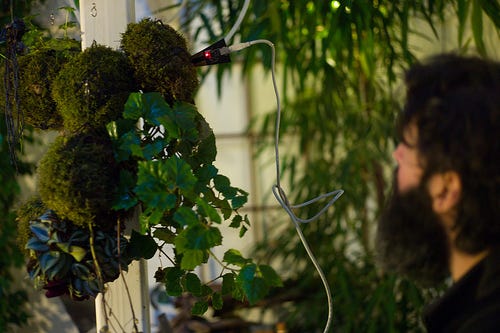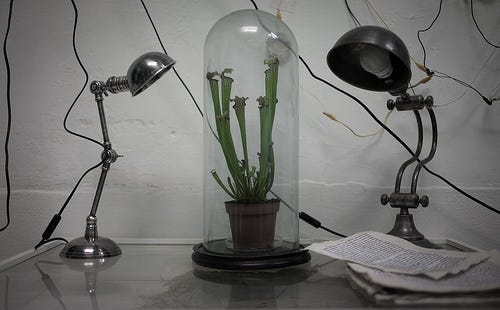Viriditas and Thalience
by Maja Kuzmanovic, Nik Gaffney and FoAM
https://medium.com/invironment/groworld-c777f5c09c4f

The interconnectedness of the human and the vegetal has been a recurring, age-old theme in art, science and religion. Medieval healer and mystic Hildegard of Bingen wrote about plants radiating a greening life-force (Roth 2000), which she called viriditas. Any translation of viriditas into words and symbols would remain inadequate, but it is a phenomenon that can be viscerally experienced by most humans. Viriditas can be felt while walking through a lush forest, or picking leafy greens from a garden. It is the feeling of freshness and incomprehensible greenness, a quiet, elemental consciousness permeating all life. Sadly, the cultural values of our times seem to have strayed away from viriditas in favour of the active aspects of our animal attributes — speed, expansion, predation and consumption. The balance has tipped toward the bestial side of humanity at the expense of the vegetal. However, we can reacquaint ourselves with viriditas when we slow down, become still but acutely present, like a plant. We can witness viriditas in our own resilience, awareness, compassion and contemplation.
Most noble
evergreen with your roots
in the sun:
you shine in the cloudless
sky of a sphere no earthly
eminence can grasp,
enfolded in the clasp
of ministries divine.
— Hildegard Von Bingen
While viriditas can be an experiential and spiritual muse of a vegetal human culture, for the analytically inclined a more empirical approach to the idea of vegetal sentience is needed (aside from the well-known psychedelic and shamanistic perspectives). Justifiably, before encouraging development of a vegetal mind in humans, we’d like to understand the plant’s point of view first, rather than modelling our human existence on an incomplete interpretation. We might want to engage with the botanical kingdom directly, and grasp how plants perceive and communicate. There are several examples from both mainstream and fringe science looking at plant perception, signalling and sentience. Daniel Chamovitz recently wrote about how plants experience and respond to the world (Chamovitz 2012). Plant neurobiology developed in the last decade as a scientific discipline researching plants’ signalling and adaptive behaviour (Barlow 2008). On the edges of scientific replicability, we find Clive Backster’s biocommunication experiments with a specimen of Dracena Massengeana connected to a polygraph (Backster 2003), or the imaginative crescographs by Jagdish Chandra Bose and Randall Fontes (Theroux 1997). These experiments look at plant growth and movement in response to external stimuli, and attempt to understand plant perception and communication.

Venturing to communicate with plants would require humans to grasp the logic of the “vegetal mind.” Plant consciousness would no doubt be considered alien and impossible to perceive without assistance. This is where knowledge of human-computer interaction might be informative. The field of computer science has developed a variety of methods to determine the nature of machine mind by comparing it to the human mind (the Turing test being the best known example). However, it is quite anthropocentrically arrogant to think that human sentience, perception and behaviour is the only possible expression of consciousness. Why measure sentience by how well it mirrors that of humans? Nature may contain a myriad of disparate sentiences, operating according to their own internally consistent, externally incomprehensible logic. We might be “hearing their voices” daily, but having no sensory and mental capacity to translate and interpret their meaning. Perhaps we should focus our energies on “an attempt to give the physical world itself a voice so that rather than us asking what reality is, reality itself can tell you” (Schroeder, retrieved 2008). Writer Karl Schroeder called this “post-scientific” communication with non-human sentient beings “thalience.” A plant-inspired culture could benefit from getting to know its verdant neighbours from a range of perspectives, including direct and unmediated experience, moving away from teleological, utilitarian and reductionist analyses of human relationships with plants. Schroeder talks about “non-human intelligences who come to different conclusions about what the universe [is] like” (Schroeder, retrieved 2008). Plants are such “non-human intelligences” with whom we share the same universe, yet the way in which they experience the world remains beyond our grasp.
We have nothing in common with the Geometers. No shared experiences, no common culture. Until that changes, we can’t communicate with them. Why not? Because language is nothing more than a stream of symbols that are perfectly meaningless until we associate them, in our minds, with meaning; a process of acculturation. Until we share experiences with the Geometers, and thereby begin to develop a shared culture — in effect, to merge our culture with theirs — we cannot communicate with them, and their efforts to communicate with us will continue to be just as incomprehensible as the gestures they’ve made so far.
— Neal Stephenson
At the intersections of culture, gardening and technology we can start to see how plants can become organisational principles for human society in the turbulent times of the 21st century. Although we may need to scavenge at the fringes of contemporary society, we can observe many healing effects that humans can have on their surroundings through a symbiotic collaboration with plants. Some fight desertification and remediate industrial wastelands through natural farming and permaculture. Others design whole lifecycle, closed-loop technological and architectural systems inspired by natural processes, based on the art and science of biomimicry. Yet, these are scattered examples. We still don’t have widespread methods to improve wasteful, often counter-productive human behaviours. How do we encourage broader, longer-term cultural changes? What varieties of culture would be capable of forging symbiotic relationships between postindustrial human societies and the rest of the earth? How do we compost bitterness to grow beauty?
From these questions and assertions sprouted the groWorld initiative, a long-term inquiry into human-plant interactions and their effect on the longevity of human culture. The people of FoAM — a distributed laboratory for speculative culture — initiated groWorld to “minimise borders and maximise edges” between the man-made and the vegetal. In these zones of liminality and ambiguity, groWorld abets “unholy alliances” between contemporary culture and cultivation, building and growing, botany and technology. Inspired by the way in which plant species propagate – spanning multiple temporal layers – the initiative encompasses both long- and short-term explorations. The slow processes of cultural adaptation and plant cultivation are researched across several decades, through observation and interaction. At the same time, quick technological and social changes are incorporated through techno-artistic experiments in three interconnected branches: {sym}, {bio} and {sys}. The {sym} branch looks at how human culture can be infused with vegetal characteristics: in botanical fiction, plant games, active materials, and responsive environments. The {bio} branch is about a direct collaboration with plants, using age-old techniques of foraging and gardening and seeing cities as edible landscapes for humans and non-humans. Finally, {sys} deals with botanically-inspired technologies that can help humans engage with plants beyond the physical level, through sensing, perception and perhaps even communication.

Through a cross-fertilisation of {sym}{bio}{sys}, groWorld merges digital culture with environmentalism. Both approaches promote empowerment of trans-local communities and are rooted in self-reliant maker-cultures, yet they don’t often mingle. groWorld encourages their interaction by bringing programmers and gardeners, gamers and botanists together on the common ground of the arts. Together, they create hybrids of gardening and technology, or narrative realities where human and vegetal can merge into a unified, hybrid culture.